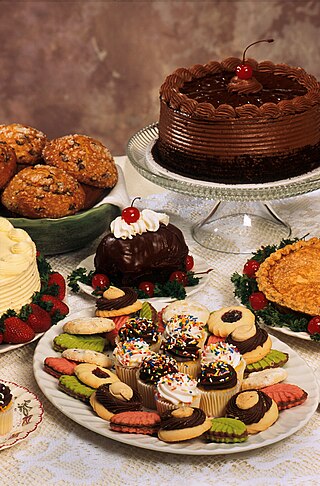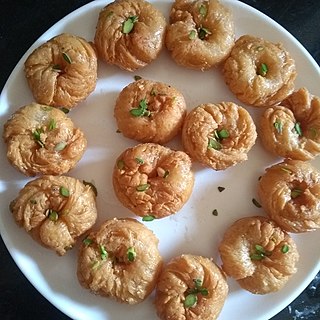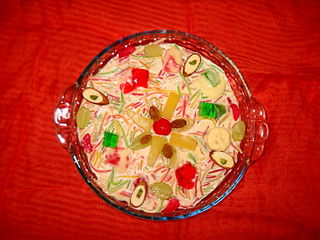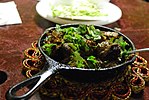
Dessert is a course that concludes a meal. The course consists of sweet foods, such as cake, biscuit, ice cream and possibly a beverage such as dessert wine and liqueur. Some cultures sweeten foods that are more commonly savory to create desserts. In some parts of the world there is no tradition of a dessert course to conclude a meal.

Cannoli are a Sicilian pastry consisting of a tube-shaped shell of fried pastry dough, filled with a sweet, creamy filling containing ricotta cheese. Its size ranges from 9 to 20 centimetres. In mainland Italy, it is commonly known as cannolo siciliano.

Jalebi, is a popular sweet snack in the Indian subcontinent, West Asia and some parts of Africa. It goes by many names, including jilapi, zelepi, jilebi, jilipi, zulbia, jerry, mushabak, z’labia, or zalabia.

Rasgulla is a syrupy dessert popular in the eastern part of South Asia. It is made from ball-shaped dumplings of chhena dough, cooked in light sugar syrup. This is done until the syrup permeates the dumplings.
Mithai (sweets) are the confectionery and desserts of the Indian subcontinent. Thousands of dedicated shops in India, Bangladesh, Nepal, Pakistan and Sri Lanka sell nothing but sweets.

Sindhi cuisine refers to the distinct native cuisine of the Sindhi people from Sindh, Pakistan. Sindhi cuisine has been influenced by Central Asian, Iranian, Mughal food traditions. It is mostly a non-vegetarian cuisine, with even Sindhi Hindus widely accepting of meat consumption. The daily food in most Sindhi households consists of wheat-based flat-bread (Mani) or rice accompanied by two dishes, one gravy and one dry with curd, papad or pickle. Freshwater fish and a wide variety of vegetables are usually used in Sindhi cuisine. Restaurants specializing in Sindhi cuisine are rare, although it is found at truck stops in rural areas of Sindh province, and in a few restaurants in urban Sindh.

Kalakand is a sweet cheese confection from India. It has been described as "akin to Italian cheesecake, firmer in texture than milk cake, but softer than burfis."

Knafeh is a traditional Arabic dessert, made with spun pastry called kataifi, soaked in a sweet, sugar-based syrup called attar, and typically layered with cheese, or with other ingredients such as clotted cream, pistachio or nuts, depending on the region. It is popular in the Middle East.

Basbousa is a sweet, syrup-soaked semolina cake that is typically associated with Egyptian cuisine, and is also popular in the wider region. The semolina batter is baked in a sheet pan, then sweetened with orange flower water, rose water or simple syrup, and typically cut into diamond (lozenge) shapes or squares.

Makhan Bada is a traditional dessert originating from the Indian subcontinent. It is also known as Balusaahi and is similar to a glazed doughnut in terms of Ingredients, but differs in texture and taste. Makhan Bada also resembles Rajasthani Baati in terms of size & preparation but resembles more with Medu Vada in terms of shape. In South India, a similar pastry is known as badusha.

Turkish delight or lokum (/lɔ.kʊm/) or halgoum is a family of confections based on a gel of starch and sugar. Premium varieties consist largely of chopped dates, pistachios, hazelnuts or walnuts bound by the gel; traditional varieties are often flavored with rosewater, mastic gum, bergamot orange, or lemon. Other common flavors include cinnamon and mint. The confection is often packaged and eaten in small cubes dusted with icing sugar, copra, or powdered cream of tartar to prevent clinging. In the production process, soapwort may be used as an emulsifying additive.

Gajar ka halwa, also known as Gajorer halwa, Gajarno halwo, Gajrela, Gajar pak, and carrot pudding is a carrot-based sweet dessert pudding made by placing grated carrots in a pot containing a specific amount of water, milk, sugar, and cardamom and then cooking while stirring regularly. It is often served with a garnish of almonds and pistachios. The nuts and other items used are first sautéed in ghee, a type of clarified butter from the Indian subcontinent.

Saraiki cuisine refers to the native cuisine of the Saraiki people in central Pakistan. It is one of the key part of the Pakistani and South Asian cuisines. The style of cooking is present in the Saraiki-speaking region of southern Punjab, as well as parts of southern Khyber Pakhtunkhwa, northern Sindh and northeastern Balochistan. Saraiki food comprises many unique local dishes, and also shares influences with neighbouring regional cuisines. The metropolitan city of Multan is a hub of Saraiki cooking.

Lab-e-Shireen is a traditional Pakistani custard-like dessert. It is often served during the month of Ramadan or during the days of Eid. It is served topped with vermicelli, cream, jelly, and fresh and dried fruits. Lab-e-Shireen is one of the most popular desserts in the modern cooking of Pakistan.

The Confectional is a bakery and cheesecake company with multiple locations in Seattle, in the U.S. state of Washington. The original shop is located at Pike Place Market in the city's Central Waterfront district. Subsequent locations opened on Capitol Hill in 2011 and at the Armory in Seattle Center.






























